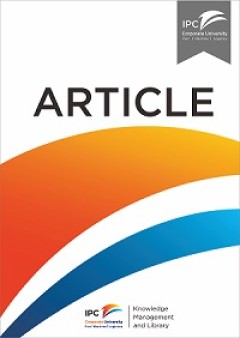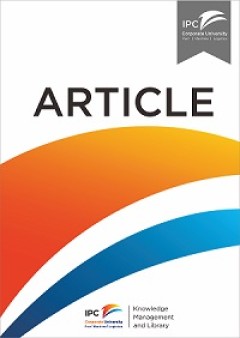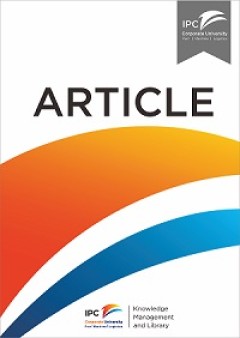Ditapis dengan

Unified heuristics to solve routing problem of reverse logistics in sustainab…
A reverse logistics problem, motivated by many real-life applications, is examined where bottles/cans in which products are delivered from a processing depot to customers in one period are available for return to the depot in the following period. The picked-up bottles/cans need to be adjusted in the place of delivery load. This problem is termed as simultaneous delivery and pick-up problem wit…
- Edisi
- Vol. 41, No. 3, March 2010, 337–351
- ISBN/ISSN
- 1464–5319
- Deskripsi Fisik
- 16 p.
- Judul Seri
- International Journal of Systems Science
- No. Panggil
- ATC LO ANB u

Scheduling trucks in container terminals using a genetic algorithm
Trucks are the most popular transport equipment in most mega-terminals, and scheduling them to minimize makespan is a challenge that this article addresses and attempts to resolve. Specifically, the problem of scheduling a fleet of trucks to perform a set of transportation jobs with sequence dependent processing times and different ready times is investigated, and the use of a genetic algorithm…
- Edisi
- Vol. 39, No. 1, January 2007, 33–47
- ISBN/ISSN
- 1029-0273
- Deskripsi Fisik
- 16 p.
- Judul Seri
- Engineering Optimization
- No. Panggil
- ATC LO CNG s

Determine the optimal carrier selection for a logistics network based on mult…
From the perspective of supply chain management, the selected carrier plays an important role in freight delivery. This article proposes a new criterion of multi-commodity reliability and optimises the carrier selection based on such a criterion for logistics networks with routes and nodes, over which multiple commodities are delivered. Carrier selection concerns the selection of exactly one ca…
- Edisi
- Vol. 44, No. 5, May 2013, 949–965
- ISBN/ISSN
- 1464–5319
- Deskripsi Fisik
- 18 p.
- Judul Seri
- International Journal of Systems Science
- No. Panggil
- ATC LO LIN y

Cross-dock job assignment problem in space-constrained industrial logistics d…
This paper addresses a cross-dock operations problem in space-constrained industrial logistics distribution hubs. In these hubs, the number of incoming trucks exceeds the number of docks available, and inbound trucks and orders arrive at random. The solution lies in minimising the waiting time of trucks by coordinating the pick up/delivery sequences of inbound and outbound orders in the storage…
- Edisi
- Vol. 50, No. 9, 1 May 2012, 2439–2450
- ISBN/ISSN
- 1366–588X
- Deskripsi Fisik
- 13 p.
- Judul Seri
- Cross-dock job assignment problem in spaceconstrained industrial logistics distribution hubs with a single docking zone
- No. Panggil
- ATC LO CHO c

Biased random key genetic algorithm for the Tactical Berth Allocation Problem
The Tactical Berth Allocation Problem (TBAP) aims to allocate incoming ships to berthing positions andassign quay crane profiles to them (i.e. number of quay cranes per time step). The goals of the TBAPare both the minimization of the housekeeping costs derived from the transshipment container flowsbetween ships, and the maximization of the total value of the quay crane profiles assigned to the…
- Edisi
- 2014
- ISBN/ISSN
- -
- Deskripsi Fisik
- 18 p.
- Judul Seri
- Applied Soft Computing
- No. Panggil
- ATC LO RUI b

A simulation optimization approach for solving the dual-cycling problem in co…
Dual cycling is an operation technique whereby quay cranes perform loading and unloading operations simultaneously in the same ship bay. In this article, a mixedinteger programming model for quay crane dual-cycling scheduling is developed. The model considers the stowage plan of outbound containers and the operation sequence of quay cranes. To solve the model, a heuristic method, called bi-leve…
- Edisi
- 2015
- ISBN/ISSN
- -
- Deskripsi Fisik
- 23p
- Judul Seri
- Maritime Policy & Management: The flagship journal of international shipping and port research
- No. Panggil
- ATC LO ZEN a

An optimization approach to risk decision-making of closed-loop logistics bas…
In green logistics operation, all logistics processes form a bidirectional closed-loop topology. In order to model and optimize such a kind of structure, a standardized closed-loop logistics operation reference model is built which aims to provide supply chain managers with general analysis. Based on the reference model, potential risks of closed-loop logistics chain can be analyzed including n…
- Edisi
- Vol. 61, No. 10, October 2012
- ISBN/ISSN
- -
- Deskripsi Fisik
- 32 p.
- Judul Seri
- Optimization: A Journal of Mathematical Programming and Operations Research
- No. Panggil
- ATC LO ZHA a

Genetic algorithms to schedule container transfers at multimodal terminals
Optimising the container transfer schedule at the multimodal terminals is known to be NP-hard, which implies that the best solution becomes computationally infeasible as problem sizes increase. Genetic Algorithm (GA) techniques are used to reduce container handling/transfer times and ships' time at the port by speeding up handling operations. The GA is chosen due to the relatively good results …
- Edisi
- -
- ISBN/ISSN
- -
- Deskripsi Fisik
- 19 p.
- Judul Seri
- -
- No. Panggil
- ATC LO PRE g

Planning vehicle transhipment in a seaport automobile terminal using a multi-…
A multi-agent system (MAS) for supporting the planning of transhipments of imported finished vehicles via a seaport is presented. The focus is on storage allocation, i.e. the allocation of parking areas for the temporary storage of vehicles, and on deployment scheduling, i.e. the allocation of drivers to the vehicles that have to be moved in the terminal area. These planning tasks, which in pra…
- Edisi
- volume 166 2005 726–740
- ISBN/ISSN
- -
- Deskripsi Fisik
- 15 p.
- Judul Seri
- European Journal of Operational Research
- No. Panggil
- ATC LO GEH p

A genetic algorithm heuristic for solving the quay crane scheduling problem w…
One of the most important operations in marine container terminals is quay crane scheduling. The quay crane scheduling problem (QCSP) involves scheduling groups of containers to be loaded and unloaded by each quay crane. It also requires addressing practical issues such as minimum spacing between quay cranes and precedence relationships between container groups. This study addresses the QCSP wi…
- Edisi
- Maritime Economics & Logistics (2015) 17, 515–537
- ISBN/ISSN
- -
- Deskripsi Fisik
- 23 pages
- Judul Seri
- -
- No. Panggil
- ATC PO KAV g

A genetic algorithm to solve the storage space allocation problem in a contai…
In this paper, an efficient genetic algorithm (GA) is presented to solve an extended storage space allocation problem (SSAP) in a container terminal. The SSAP is defined as the temporary allocation of the inbound/outbound containers to the storage blocks at each time period with aim of balancing the workload between blocks in order to minimize the storage/retrieval times of containers. An exten…
- Edisi
- -
- ISBN/ISSN
- 0360-8352
- Deskripsi Fisik
- 9 p.
- Judul Seri
- -
- No. Panggil
- ATC LO BAZ a

Stacker-reclaimer scheduling in a dry bulk terminal
A dry bulk terminal acts as a multi-modal interface for transhipping iron ores. Stacker reclaimers are the dedicated equipments in storage yard for iron ore handling. Both unloading and loading processes are supported by stackerreclaimers in most cases. The operation efficiency of dry terminals heavily depends on the productivity of stackerreclaimers. This paper discusses the stacker-reclaimer …
- Edisi
- vol. 25
- ISBN/ISSN
- 1362-3052
- Deskripsi Fisik
- 13 p.
- Judul Seri
- International Journal of Computer Integrated Manufacturing
- No. Panggil
- ATC PO DAY s

A methodology to support decision-making on sugar distribution for export cha…
Supply chain research can lead to an increase in efficiency, business integration, responsiveness and ultimately market competitiveness. In the sugar industry, such research has expanded rapidly over the past two decades, and has been motivated by low world sugar prices and rising costs of production. However, in the present competitive business environment, a more customer-driven and holistic…
- Edisi
- -
- ISBN/ISSN
- -
- Deskripsi Fisik
- 14 p.
- Judul Seri
- -
- No. Panggil
- ATC PO CHI a
 Karya Umum
Karya Umum  Filsafat
Filsafat  Agama
Agama  Ilmu-ilmu Sosial
Ilmu-ilmu Sosial  Bahasa
Bahasa  Ilmu-ilmu Murni
Ilmu-ilmu Murni  Ilmu-ilmu Terapan
Ilmu-ilmu Terapan  Kesenian, Hiburan, dan Olahraga
Kesenian, Hiburan, dan Olahraga  Kesusastraan
Kesusastraan  Geografi dan Sejarah
Geografi dan Sejarah